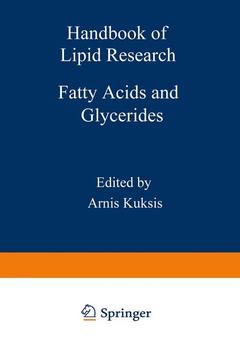Fatty Acids and Glycerides, Softcover reprint of the original 1st ed. 1978 Handbook of Lipid Research Series, Vol. 1
Langue : Anglais
Coordonnateur : Kuksis A.

The advances in lipid biochemistry over the past 25 to 30 years have been dramatic and exciting. The elucidation of the pathways of fatty acid biosynthesis and oxidation, the delineation of the biogenesis of cholesterol from small-molecular weight precursors, the structure proof of simple and complex lipids from plants, animals, and microorganisms, are excellent examples of the spectacular advances made during the golden era of lipid biochemistry. The multifaceted discoveries in these diverse areas of study could be attributed to development of highly sophisticated column chromatographic techniques for separation and purification of simple and complex lipids. The advent of thin-layer chromatography as well as gas liquid chromatography provided an explosive impetus to research developments in this field. Concomitant advances in mass spectrometry allowed an interface with gas-liquid chromatography which spawned even greater insight into the structure of lipids. These eventful days of lipid chemistry nearly 25 years ago led to a relatively quiescent period wherein scientists applied these newly available techniques to investigation of the behavior of isolated (lipid) enzyme systems and to unraveling the intricacies of the metabolic behavior of lipids in the intact cell or whole organisms. Then, in the early 1960s, a decided change in research emphasis developed with the advent of a simple, reproducible procedure for the isolation of cell membranes.
1 Separation and Determination of Structure of Fatty Acids.- 1.1. Introduction.- 1.2. Preparation and Isolation of Fatty Acids.- 1.3. Preliminary Fractionation of Fatty Acids.- 1.4. Identification of Fatty Acids by Gas—Liquid Chromatography.- 1.5. Identification of Fatty Acids by Gas Chromatography/Mass Spectrometry.- 1.6. Ancillary Methods of Fatty Acid Identification.- 1.7. Summary and Conclusions.- 1.8. References.- 2 Synthesis and Analysis of Stable Isotope- and Radioisotope-Labeled Fatty Acids.- 2.1. Introduction.- 2.2. Synthesis of Stable Isotope-Labeled Fatty Acids.- 2.3. Synthesis of Radioisotope-Labeled Fatty Acids.- 2.4. Analysis of Radioisotope-Labeled Fats.- 2.5. Analysis of Stable Isotope-Labeled Fatty Acids.- 2.6. Summary.- 2.7. References.- 3 Separation and Determination of the Structure of Acylglycerols and Their Ether Analogues.- 3.1. Introduction.- 3.2. Nomenclature.- 3.3. Selected Methods for Modifying or Degrading Glycerolipids.- 3.4. Derivatization Procedures.- 3.5. Determination of the Structural Components of Glycerolipids.- 3.6. Extraction and Purification of Lipids.- 3.7. Thin-Layer Chromatography.- 3.8. Liquid Chromatography.- 3.9. Gas Chromatography.- 3.10. Mass Spectrometry.- 3.11. Other Techniques.- 3.12. Combined Techniques.- 3.13. Conclusions.- 3.14. References.- 4 Stereospecific Analysis of Triacylglycerols.- 4.1. Introduction.- 4.2. Physical and Chemical Methods for the Determination of Stereochemical Distribution of Fatty Acids in Triacylglycerols.- 4.3. Enzymatic Methods for Determination of Stereochemical Distribution of Fatty Acids in Triacylglycerols.- 4.4. Positional Distribution of Fatty Acids in Natural Triacylglycerols.- 4.5. Concluding Remarks.- 4.6. References.- 5 Stereospecific Synthesis of Enantiomeric Acylglycerols.- 5.1.Introduction.- 5.2. General Procedures for Specification of Absolute Configuration of Enantiomeric sn-Glycerol Derivatives.- 5.3. Sources and Practical Methods for Preparation of Enantiomeric sn-Glycerol Derivatives.- 5.4. Methods of Configurational Conversion and Inversion of sn-Glycerol Derivatives.- 5.5. Selection of Protective Groups for Stereospecific Synthesis of Acyl-, Alkyl-, and Alkylacyl-sn-glycerols.- 5.6. Stereospecific Acylation of Enantiomeric sn-Glycerol Derivatives.- 5.7. Synthesis of Enantiomeric Isotope-Labeled Acyl- and Alkylacyl-sn-glycerols.- 5.8. Methods of Isolation and Purification of Synthetic Acyl-sn-glycerols.- 5.9. Determination of Structure and Absolute Configuration of Synthetic and Natural Acyl-sn-glycerols.- 5.10. Summary and Conclusions.- 5.11. References.- 6 Metabolic Studies with Natural and Synthetic Fatty Acids and Enantiomeric Acylglycerols.- 6.1. Introduction.- 6.2. Activation of Fatty Acids.- 6.3. Biosynthesis of Phosphatidic Acid.- 6.4. Biosynthesis of Diacylglycerols.- 6.5. Biosynthesis of Triacylglycerols.- 6.6. Factors Influencing the Biosynthesis of Acylglycerols.- 6.7. Methods Employed in Studying the Biosynthesis of Acylglycerols.- 6.8. Kinetic Problems Encountered in Enzyme Assays Involving Lipid Substrates.- 6.9. Enzymatic Lipolysis of Acylglycerols.- 6.10. Summary and Conclusions.- 6.11. References.- 7 Composition of Selected Dietary Fats, Oils, Margarines, and Butter.- 7.1. Introduction.- 7.2. Methodology.- 7.3. Basic Processing.- 7.4. Source Oils.- 7.5. Confectionery Products.- 7.6. Nuts.- 7.7. Cooking Oils.- 7.8. Shortenings.- 7.9. Margarines.- 7.10. Dairy Products and Creamers.- 7.11. Animal Fats.- 7.12. Marine Products.- 7.13. Summary and Trends.- 7.14. References.- 8 Fatty Acid Composition of Glycerolipids of Animal Tissues.- 8.1. Introduction.- 8.2. Methods of Analysis.- 8.3. Fatty Acids of Different Animal Species and Man.- 8.4. Fatty Acids of Individual Animal Species and Man.- 8.5. Summary and Conclusions.- 8.6. References.
Date de parution : 04-2012
Ouvrage de 469 p.
17.8x25.4 cm
Thèmes de Fatty Acids and Glycerides :
Mots-clés :
Lipid; Oxidation; biochemistry; cell membrane; chemistry; enzyme; enzymes; structure; synthesis
© 2024 LAVOISIER S.A.S.



